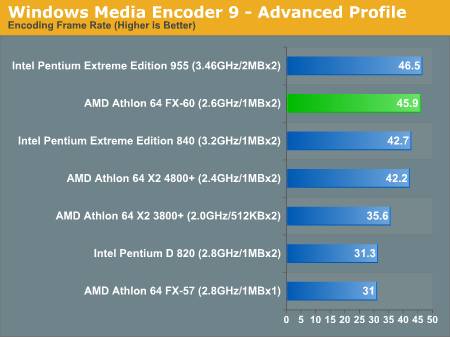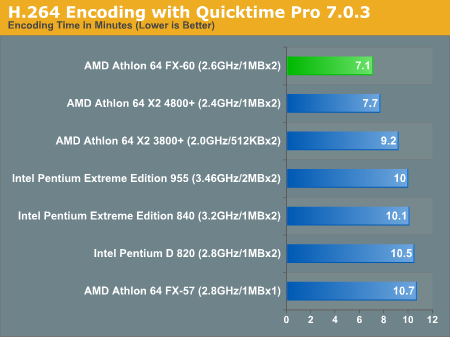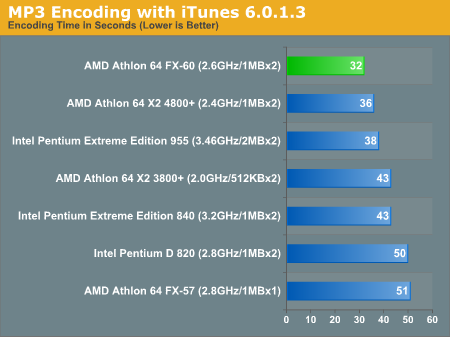AMD Athlon 64 FX-60: A Dual-Core farewell to Socket-939
by Anand Lal Shimpi on January 9, 2006 11:59 PM EST- Posted in
- CPUs
Media Encoding Performance using DVD Shrink, WME9, Quicktime and iTunes
First up is DVD Shrink 3.2.0.15. Our test was simple - we took a copy of Star Wars Episode VI and ripped the full DVD to the hard drive without compression, effectively giving us an exact copy of the disc on the hard drive. Then, using the copy of the DVD on the hard drive (to eliminate any DVD drive bottlenecks), we performed a DVD shrink operation to shrink the movie to fit on a single 4.5GB DVD disc. All of the options were left on their defaults, so the test ends up being pretty easy to run and reproduce. The scores reported are DVD encoding times in minutes, with lower numbers meaning better performance.
The DVD Shrink test is quite important as DVD Shrink is quite possibly one of the easiest tools to rip a DVD. The easier a tool is to use, the more likely it's going to be used, and arguably the more important performance using it happens to be.
Moving on, we have our Windows Media Encoder 9 test, which uses the advanced profile settings for video encoding. We left all settings at their defaults and just proceeded with a MPEG-2 to WMV-HD conversion. The values reported are in frames per second, with higher numbers being better.
Next up, we have Quicktime Pro 7.0.3 and we perform a MPEG-2 to H.264 encoding task. All of the settings are left at their defaults, with the exception that we optimize the output file for download with a 256kbps data rate while leaving the resolution untouched. We also adjust the video options to optimize for the best quality. We report the transcoding time in minutes, with lower values being better.
Finally, we have a MP3 encoding test using iTunes 6.0.1.3. For this test, we simply took a 304MB wav file and converted it to a 192kbps MP3 file, measuring the encode time in seconds. The only iTunes option that we changed was to prevent the playback of the song while encoding.
First up is DVD Shrink 3.2.0.15. Our test was simple - we took a copy of Star Wars Episode VI and ripped the full DVD to the hard drive without compression, effectively giving us an exact copy of the disc on the hard drive. Then, using the copy of the DVD on the hard drive (to eliminate any DVD drive bottlenecks), we performed a DVD shrink operation to shrink the movie to fit on a single 4.5GB DVD disc. All of the options were left on their defaults, so the test ends up being pretty easy to run and reproduce. The scores reported are DVD encoding times in minutes, with lower numbers meaning better performance.
The DVD Shrink test is quite important as DVD Shrink is quite possibly one of the easiest tools to rip a DVD. The easier a tool is to use, the more likely it's going to be used, and arguably the more important performance using it happens to be.

Moving on, we have our Windows Media Encoder 9 test, which uses the advanced profile settings for video encoding. We left all settings at their defaults and just proceeded with a MPEG-2 to WMV-HD conversion. The values reported are in frames per second, with higher numbers being better.

Next up, we have Quicktime Pro 7.0.3 and we perform a MPEG-2 to H.264 encoding task. All of the settings are left at their defaults, with the exception that we optimize the output file for download with a 256kbps data rate while leaving the resolution untouched. We also adjust the video options to optimize for the best quality. We report the transcoding time in minutes, with lower values being better.

Finally, we have a MP3 encoding test using iTunes 6.0.1.3. For this test, we simply took a 304MB wav file and converted it to a 192kbps MP3 file, measuring the encode time in seconds. The only iTunes option that we changed was to prevent the playback of the song while encoding.

3D Rendering Performance using 3dsmax 7
Gaming Performance using Battlefield 2, Call of Duty 2 and Quake 4










94 Comments
View All Comments
Betwon - Tuesday, January 10, 2006 - link
Let's see the real test(better than anandtech).After OC, the tests bentween Intel 955 and AMD FX-60:
http://www.xbitlabs.com/articles/cpu/display/athlo...">http://www.xbitlabs.com/articles/cpu/display/athlo...
Cygni - Tuesday, January 10, 2006 - link
I have to say, im pretty surprised by the results in single threaded apps, like most games. Despite a 200mhz deficit, it still beats the 57... pretty interesting. Im guessing that the second core is getting SOMETHING to it... maybe the background OS procedures? Dunno.Betwon - Tuesday, January 10, 2006 - link
Stop surprising.Because The benchmark of Business Winstone 2004,Overall WorldBench 5 and Office Productivity SYSMark 2004 may be benefit from multi-core.(a little or more?)
For the multi-thread-paralle apps:
Not only Fx-60 but also PD 820 beat, beats FX-57.
http://images.anandtech.com/graphs/amd%20athlon%20...">http://images.anandtech.com/graphs/amd%...lon%2064...
http://images.anandtech.com/graphs/amd%20athlon%20...">http://images.anandtech.com/graphs/amd%...lon%2064...
http://images.anandtech.com/graphs/amd%20athlon%20...">http://images.anandtech.com/graphs/amd%...lon%2064...
http://images.anandtech.com/graphs/amd%20athlon%20...">http://images.anandtech.com/graphs/amd%...lon%2064...
http://images.anandtech.com/graphs/amd%20athlon%20...">http://images.anandtech.com/graphs/amd%...lon%2064...
highlandsun - Tuesday, January 10, 2006 - link
Agreed. The only way you'd see truly single-threaded performance on a machine would be running something like DOS that has no task scheduler whatsoever.Betwon - Tuesday, January 10, 2006 - link
No surprise about games.FX-60 is defeated by FX-57 in most games.
Only in the SMP games, FX-60 beats the FX-57, And PD 820 beats the FX-57 too.
Betwon - Tuesday, January 10, 2006 - link
No surprise about games.FX-60 is defeated by FX-57 in most games.
Only in the SMP games, FX-60 beats the FX-57, And PD 820 beats the FX-57 too.
Avalon - Tuesday, January 10, 2006 - link
I'm still amazed at the performance difference in Quake 4 between the P-D 820 and FX-60, plus the fact that dual core optimizations in the game engine enable noticeable framerate gains.Xenoterranos - Tuesday, January 10, 2006 - link
Didn't Carmack himself day that that was basically a dry-run, that they didn't really how to go about multithreading it from the start. If Carmack is basically saying that the result we see here are preliminary and "rough", I can't wait until trully optimized code comes along to max both those cores out! Maybe then a quad-sli system will be able to do some damage without suffering the diminishing returns we've recently seen.latrosicarius - Tuesday, January 10, 2006 - link
I think the future of graphics will be single cards with multiple chips/cores.Furen - Tuesday, January 10, 2006 - link
Dont get me started on diminishing returns... lol